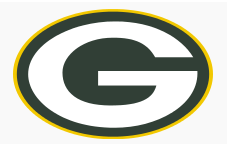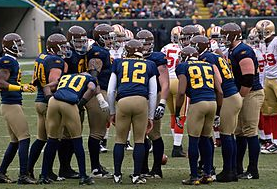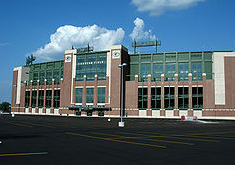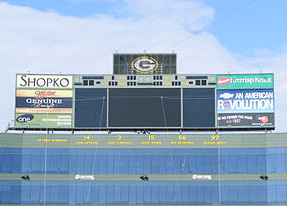
In August 2008, ESPN.com ranked the Packers as having the second-best fans in the NFL.[36] The team initially finished tied with the Pittsburgh Steelers (who finished ahead of the Packers) as having the best fans, but the tie was broken by ESPN's own John Clayton, a Pittsburgh native.
Nickname, logo, and uniforms

Packers logo (1961–present).[37]

Packers throwback jersey was first introduced in 2010.[38]
Curly Lambeau, the team's founder, solicited funds for uniforms from his employer, the Indian Packing Company. He was given $500 for uniforms and equipment, on condition that the team be named for its sponsor (a similar event would occur the following year with the Decatur Staleys, who later became the Chicago Bears). An early newspaper article referred to the new Green Bay team as "the Indians" but by the time they played their first game they had adopted the name "Packers."
In 1920, the Indian Packing Company was purchased by the Acme Packing Company. Acme continued its support of Lambeau'steam, and in its first season in the NFL the team wore jerseys with the words "ACME PACKERS" emblazoned on the chest.
Lambeau, who had attended the University of Notre Dame, borrowed the team's colors of navy blue and gold from the Irish, much as George Halas borrowed team colors from his alma materIllinois for the Chicago Bears. And like the Irish in the 1930s and 1940s, the Packers sometimes used green and gold before returning to the traditional blue and gold.
In the early days, the Packers were often referred to as the "Bays" or the "Blues" (and even occasionally as "the Big Bay Blues"). These never were official nicknames, although Lambeau did consider replacing "Packers" with "Blues" in the 1920s.
By 1950, the Packers changed their colors to hunter green and gold. Navy blue was kept as a secondary color, seen primarily on sideline capes, but it was quietly dropped from the team colors list on all official materials shortly thereafter. The color scheme yields the common Packer nickname, "The Green and Gold". In 1994, the NFL's 75th anniversary season, the team participated in the league-wide use of "throwback" jerseys. The Packers would wear them again for two Thanksgiving Day games against the Detroit Lions: in 2001, throwback uniforms as worn in the 1930s; in 2003, uniforms from the 1960s (which were only slightly different from the current uniforms).[39][40]

The Green Bay Packers in their throwback navy blue uniforms in 2010.
The oval "G" logo which stands for the "G" in Green Bay was created in 1961. Lombardi asked Packers equipment manager Gerald "Dad" Braisher to design a logo for the team's helmets. Braisher then had his assistant, St. Norbert College art student John Gordon, come up with potential designs. After Braisher and Gordon were satisfied with the design, a football-shaped letter "G", they presented it to Lombardi who then approved it.[41] Tiki Barber falsely reported[42] it to stand for "greatness" without a reliable source to back up his claims. Other reputable media outlets then published similar stories using Barber's false claim as a source.[43] The Packers' Assistant Director of PR and Corporate Communications had the following to say: "There’s nothing in our history that suggests there's any truth to this. The Packers Hall of Fame archivist said the same thing.".[44] The team used a number of different logos prior to 1961, but the "G" is the only logo that has ever appeared on the helmet.[45][46] The Packers hold the trademark on the "G" logo, and have granted limited permission to other organizations to utilize a similar logo, such as the University of Georgia and Grambling State University.[47] Adopted in 1964, the Georgia "G", though different in design and color, was similar to the Packers' "G". Then-Georgia head coach Vince Dooley thought it best to clear the use of Georgia's new emblem with the Packers.[citation needed]
While several NFL teams choose to wear white jerseys at home early in the season due to white's ability to reflect the late summer sunrays, the Packers have done so only twice, during the opening two games of the 1989 season. Although alternate gold jerseys with green numbers are sold on a retail basis, the team currently has no plans to introduce such a jersey to be used in actual games.
During the 2010 season, the Packers paid tribute to their historical brethren with a third jersey modeled after that worn by the club in 1929, during its first world championship season. The jersey was navy blue, again making the Packers "the Blues."[48][49]
Upon the NFL's switch of uniform suppliers in 2012 to Nike from Reebok, the Packers refused any changes to their uniform in any way outside of the required supplier's logo and new league uniform logos, declining all of Nike's "Elite 51" enhancements, including retaining the traditional striped collar of the jersey rather than Nike's new collar design.[50]
Stadium history

Lambeau Field after its 2003 renovation
Main article: Lambeau Field
After their early seasons at Bellevue Park and Hagemeister Park, the Packers played home games in City Stadium from 1925 to 1956. The team won its first 6 NFL world championships while calling City Stadium its home.
Once the NFL threatened to move the franchise to Milwaukee if stadium conditions were not improved in Green Bay, the city responded by building a modern facility for the Packers, open in time for the1957 season. The new stadium became the first built exclusively for an NFL team. Lambeau Field was originally known as City Stadium, like its predecessor, but its name was changed in 1965 after the death of Curly Lambeau.
When Lambeau Field opened in 1957, it had a seating capacity of 32,150. The stadium was expanded seven times before the end of the 1990s, and seating capacity reached 60,890. In 2003, Lambeau Field was extensively renovated to expand seating, modernize stadium facilities, and add an atrium area. These renovations raised Lambeau Field's seating capacity to 72,928. Despite the multiple expansions of Lambeau Field, ticket demand has far outpaced supply, as all Packers games have been sold out since 1960. About 86,000 names are on the waiting list for season tickets.[29]
The Packers played part of their home slate in Milwaukee starting in 1933, including two to three home games each year in Milwaukee's County Stadium from 1953 to 1994. The Packers worked to capture their growing fan base in Milwaukee and the larger crowds. By the 1960s, threat of an American Football League franchise in Milwaukee prompted the Packers to stay, including scheduling a Western Conference Playoff in 1967. Since County Stadium was primarily a baseball stadium, the field could barely fit a football field, and the end zones extended onto the warning track. By 1994, improvements and seating expansions at Lambeau, along with the Brewers preparing to campaign for their new stadium and withdraw a football layout from the plans[citation needed] prompted the Packers to leave County Stadium after 62 years in Milwaukee, and again be based solely in Green Bay. Former season ticketholders for the Milwaukee package continue to receive preference for one pre-season and the second and fifth regular season games at Lambeau Field each season, along with playoff games through a lottery under the "Gold Package" plan.[51]
Playoff record
• 1936 NFL Championship: Green Bay Packers 21, Boston Braves 6
• 1938 NFL Championship: New York Giants 23, Green Bay Packers 17
• 1939 NFL Championship: Green Bay Packers 27, New York Giants 0
• 1941 Western Division Championship: Chicago Bears 33, Green Bay Packers 14
• 1944 NFL Championship: Green Bay Packers 14, New York Giants 7
• 1960 NFL Championship: Philadelphia Eagles 17, Green Bay Packers 13
• 1961 NFL Championship: Green Bay Packers 37, New York Giants 0
• 1962 NFL Championship: Green Bay Packers 16, New York Giants 7
• 1965 Western Conference Championship: Green Bay Packers 13, Baltimore Colts 10 (OT)
• 1965 NFL Championship: Green Bay Packers 23, Cleveland Browns 12
• 1966 NFL Championship: Green Bay Packers 34, Dallas Cowboys 27
• Super Bowl I: Green Bay Packers 35, Kansas City Chiefs 10
• 1967 Conference Championship: Green Bay Packers 28, Los Angeles Rams 7
• 1967 NFL Championship: Green Bay Packers 21, Dallas Cowboys 17
• Super Bowl II: Green Bay Packers 33, Oakland Raiders 14
• 1972 Divisional: Washington Redskins 16, Green Bay Packers 3
• 1982 First Round: Green Bay Packers 41, St. Louis Cardinals 16
• 1982 Second Round: Dallas Cowboys 37, Green Bay Packers 26
• 1994 Wild Card: Green Bay Packers 16, Detroit Lions 12
• 1994 Divisional: Dallas Cowboys 35, Green Bay Packers 9
• 1995 Wild Card: Green Bay Packers 37, Atlanta Falcons 20
• 1995 Divisional: Green Bay Packers 27, San Francisco 49ers 17
• 1995 NFC Championship: Dallas Cowboys 38, Green Bay Packers 27
• 1996 Divisional: Green Bay Packers 35, San Francisco 49ers 14
• 1996 NFC Championship: Green Bay Packers 30, Carolina Panthers 13
• Super Bowl XXXI: Green Bay Packers 35, New England Patriots 21
• 1997 Divisional: Green Bay Packers 21, Tampa Bay Buccaneers 7
• 1997 NFC Championship: Green Bay Packers 23, San Francisco 49ers 10
• Super Bowl XXXII: Denver Broncos 31, Green Bay Packers 24
• 1998 Wild Card: San Francisco 49ers 30, Green Bay Packers 27
• 2001 NFC Wild Card: Green Bay Packers 25, San Francisco 49ers 15
• 2001 Divisional: St. Louis Rams 45, Green Bay Packers 17
• 2002 NFC Wild Card: Atlanta Falcons 27, Green Bay Packers 7
• 2003 NFC Wild Card: Green Bay Packers 33, Seattle Seahawks 27 (OT)
• 2003 Divisional: Philadelphia Eagles 20, Green Bay Packers 17 (OT)
• 2004 NFC Wild Card: Minnesota Vikings 31, Green Bay Packers 17
• 2007 Divisional: Green Bay Packers 42, Seattle Seahawks 20
• 2007 NFC Championship: New York Giants 23, Green Bay Packers 20 (OT)
• 2009 NFC Wild Card: Arizona Cardinals 51, Green Bay Packers 45 (OT)
• 2010 NFC Wild Card: Green Bay Packers 21, Philadelphia Eagles 16
• 2010 NFC Divisional: Green Bay Packers 48, Atlanta Falcons 21
• 2010 NFC Championship: Green Bay Packers 21, Chicago Bears 14
• Super Bowl XLV: Green Bay Packers 31, Pittsburgh Steelers 25
• 2011 NFC Divisional: New York Giants 37, Green Bay Packers 20
• 2012 NFC Wild Card: Green Bay Packers 23, Minnesota Vikings 14
• 2012 NFC Divisional: San Francisco 49ers 45, Green Bay Packers 31
Overall record 30 wins, 17 losses[53]
Pro Football Hall of Fame members
Main article: List of Green Bay Packers in the Pro Football Hall of Fame
The Packers have the second most members in the Pro Football Hall of Fame with 22. They trail only the Chicago Bears (with 27).[54]
• 26 Herb Adderley, CB, 1961–1969
• 3 Tony Canadeo, HB, 1941–1944; 1947–1952
• 87 Willie Davis, DE, 1960–1969
• 75 Forrest Gregg, OT, 1956; 1958–1970
• 38 Arnie Herber, QB, 1930–1940
• 30 Clarke Hinkle, FB, 1932–1941
• 5 Paul Hornung, HB, 1956–1962; 1964–1966
• 36 Cal Hubbard, OT, 1929–1933; 1935
• 14 Don Hutson, E, 1935–1945
• 74 Henry Jordan, DT, 1959–1969
• 20 Earl (Curly) Lambeau, Coach, 1919–1949 • 80 James Lofton, WR, 1978–1986
• Vince Lombardi, Coach, 1959–1967
• 24 Johnny "Blood" McNally, HB, 1929–1933
• 2 Mike Michalske, OG, 1929–1935; 1937
• 66 Ray Nitschke, LB, 1958–1972
• 51 Jim Ringo, C, 1953–1963
• 89 Dave Robinson, LB, 1963-1972
• 15 Bart Starr, QB, 1956–1971
• 31 Jim Taylor, FB, 1958–1966
• 92 Reggie White, DE, 1993–1998
• 24 Willie Wood, S, 1960–1971
Emmitt Thomas, who was inducted in the Hall of Fame for his career as a player, served as a defensive coordinator for the Packers, though he never played with them. Similar can be said for Dick LeBeau, who was elected as player and served as a defensive backfield coach for the Packers, but never played with them.
Retired numbers
Main article: List of Green Bay Packers retired numbers

Retired numbers on display in the Lambeau Field's north end zone in October 2007.
In nearly nine decades of Packers football, the Packers have formally retired 5 numbers.[55] All five Packers are members of the Pro Football Hall of Fame and their numbers and names are displayed on the green facade of Lambeau Field's north endzone as well as in the Lambeau Field Atrium.
| Green Bay Packers retired numbers | ||||
|---|---|---|---|---|
| No. | Player | Position | Career | No. retirement |
| 3 | Tony Canadeo | HB | 1941-44, 1946-52 | November 23, 1952 vs Dallas Texans at City Stadium |
| 14 | Don Hutson | WR/DB | 1935-45 | December 2, 1951 vs New York Yanks at City Stadium |
| 15 | Bart Starr | QB | 1956-71 | November 11, 1973 vs St. Louis Cardinals at Lambeau Field |
| 66 | Ray Nitschke | LB | 1958-72 | December 4, 1983 vs Chicago Bears at Lambeau Field |
| 92 | Reggie White | DE | 1993–98 | September 18, 2005 vs Cleveland Browns at Lambeau Field |
After Brett Favre stated his intent to retire in May 2008, the Packers announced that his No. 4 would be retired in a ceremony during the team's 2008 opening game against the Minnesota Vikings.[56] The ceremony was cancelled following Favre's subsequent decision to return to the game, and he was traded to the New York Jets. In March 2009, the Packers indicated that the team still intends to retire Favre's number, but due to the circumstances surrounding his departure from the team, no timeline had been set.[57]
Head coaches
Main article: List of Green Bay Packers head coaches
*Interim Head Coaches
| Name | From | To | Record | Titles | ||
| W | L | T | ||||
| Earl (Curly) Lambeau | 1919 | 1949 | 231 | 108 | 21 | 6 |
| Gene Ronzani | 1950 | 1953 | 14 | 31 | 1 | |
| Hugh Devore* | 1953 | 1953 | 0 | 2 | 0 | |
| Ray (Scooter) McLean* | ||||||
| Lisle Blackbourn | 1954 | 1957 | 17 | 31 | 0 | |
| Ray (Scooter) McLean | 1958 | 1958 | 1 | 10 | 1 | |
| Vince Lombardi | 1959 | 1967 | 98 | 30 | 4 | 5 |
| Phil Bengtson | 1968 | 1970 | 20 | 21 | 1 | |
| Dan Devine | 1971 | 1974 | 25 | 28 | 4 | |
| Bart Starr | 1975 | 1983 | 53 | 77 | 3 | |
| Forrest Gregg | 1984 | 1987 | 25 | 37 | 1 | |
| Lindy Infante | 1988 | 1991 | 24 | 40 | 0 | |
| Mike Holmgren | 1992 | 1998 | 73 | 36 | 0 | 1 |
| Ray Rhodes | 1999 | 1999 | 8 | 8 | 0 | |
| Mike Sherman | 2000 | 2005 | 56 | 39 | 0 | |
| Mike McCarthy | 2006 | current | 48 | 32 | 0 | 1 |
Radio and television
The Packers are unique in having their market area cover two media markets, both Green Bay and Milwaukee, and blackout policies for the team apply within both areas, though they have not come into effect since 1972 (the last year home game local telecasts were prohibited regardless of sellout status) due to strong home attendance and popularity – the Packers have not had a non-sellout in over 50 years.
The Packers' flagship radio station and broadcast producer is Milwaukee-based WTMJ (620) over the Packers Radio Network, with the games airing in Green Bay on WTAQ (1360/97.5), WIXX-FM (101.1), and WAPL (105.7) and WHBY (1150) in Appletonand the Fox Cities.[58] Wayne Larrivee is the play-by-play announcer and Larry McCarren is the color analyst. Larrivee joined the team after many years as the Chicago Bears' announcer.[59] Jim Irwin and Max McGee were the longtime radio announcers before Larrivee and McCarren. When victory is assured for the Packers, either a game winning touchdown, interception or a crucial 4th down defensive stop, Larrivee's trademark declaration of "And there is your dagger!" signifies the event. WTMJ has aired Packers games since 1929, the longest association between a radio station and an NFL team to date, and the only rights deal in American professional sports where a station outside of the team's main metro area is the radio flagship. In limited circumstances where the Milwaukee Brewers are in either playoff or post-season contention and their play-by-play takes priority, WTMJ's sister FM station WLWK-FM (94.5) has aired Packer games to avert game conflicts.
The TV rights for pre-season games not nationally broadcast are held by Journal Broadcast Group stations WGBA-TV (Channel 26) in Green Bay and WTMJ (Channel 4) in Milwaukee,[60] along with Quincy Newspapers' six ABC stations in the central, northern and western parts of the state, KQDS-TV (Channel 21) in Duluth-Superior, and in Escanaba/Marquette, Michigan, WLUC-TV (Channel 6), along with their Fox subchannel. As such, these stations are all allowed to use the tagline Your official Packers station in their market area by the team, and also carry the weekly coach's show hosted by WTMJ-TV's Jessie Garcia, The Mike McCarthy Show on Tuesday evenings at 6:30 pm throughout the football season. Until the end of the 2011 season, the team's partner in Green Bay was WFRV-TV (Channel 5), and sister satellite WJMN-TV in Escanaba. As part of the 2012 deal, McCarren resigned his duties as sports director of WFRV to move to WTMJ/WGBA as a Packers analyst, becoming WGBA's official sports director on April 1, 2013 as his non-compete clause to appear as a sports anchor in Green Bay expired.
The 2012 TV rights deal expanded the team's preseason network further across the Midwest. Additional stations include the Quad Cities region of Iowa/Illinois (whose coverage area stretches into the southwest corner of Wisconsin), where game coverage is carried by KLJB (Channel 18) in Davenport, Iowa and KGCW (Channel 26) in Burlington, Iowa, both owned by Grant Broadcasting System II, KCWI-TV (Channel 23) in Des Moines, and in Omaha, Nebraska, KMTV-TV (Channel 3), a sister Journal station to WTMJ and WGBA. As part of a large package of preseason football from various team networks, KFVE (Channel 9) in Honolulu, Hawaii also carried Packers state network games in the 2012 preseason. The network also added its first affiliate with Spanish language play-by-play, Milwaukee's WYTU-LD (Channel 63/49.4), a Telemundo affiliate, which airs statewide on the cable systems of Charter Communications and throughout Time Warner Cable's eastern Wisconsin systems, including Green Bay.
Pre-season coverage is produced by CBS, formerly using the NFL on CBS graphics package until the last contract ended as a renmant of WFRV's former ownership by the CBS Corporation itself until 2007. In 2012 the pre-season coverage began to use the NBC Sports Sunday Night Football graphics package due to WTMJ/WGBA's NBC affiliation. The TV play-by-play announcer, Kevin Harlan (also on loan from CBS), is the son of former Packers president Bob Harlan, with Rich Gannon joining him as color commentator. Since the 2008 pre-season all of the Packers preseason games on the statewide network are produced and aired in high definition, with WTMJ-TV subcontracting the games to minor network affiliates in Milwaukee during Summer Olympics years due to mandatory non-preemption policies by their network, NBC (this was not done in 2012 as the pre-season opener was a national ESPN game).
ESPN Monday Night Football games, both pre-season and season, are broadcast over the air on ABC affiliates WBAY-TV (Channel 2) in Green Bay and WISN-TV (Channel 12) in Milwaukee, while the stations airing Packers games in the NFL NetworkThursday Night Football package have varied. WBAY's evening news anchor Bill Jartz also serves as the public address system announcer for Lambeau Field.
The team's intra-squad Lambeau scrimmage at the beginning of the season, marketed as Packers Family Night, is broadcast by WITI (Channel 6) in Milwaukee, and produced by WLUK (Channel 11) in Green Bay, both Fox affiliates which broadcast the bulk of the team's regular-season games. The scrimmage is also broadcast by the state's other Fox affiliates.[61] It was aired for the first time in 2011 in high definition.



















